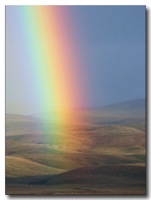Rainbow
Origin
before 1000; Middle English reinbowe, Old English regnboga; c. Old Norse regnbogi, German Regenbogen
Definitions
- 1. a bow or arc of prismatic colors appearing in the heavens opposite the sun and caused by the refraction and reflection of the sun's rays in drops of rain. Compare primary rainbow, secondary rainbow.
- 2. a similar bow of colors, esp. one appearing in the spray of a waterfall or fountain.
- 3. any brightly multicolored arrangement or display.
- 4. a wide variety or range; gamut.
- 5. a visionary goal: He pursued the rainbow of a singing career for years before becoming a success.
Description
A rainbow is an optical and meteorological phenomenon that causes a spectrum of light to appear in the sky when the Sun shines onto droplets of moisture in the Earth's atmosphere. They take the form of a multicoloured arc, with red on the outer part of the arc and violet on the inner section of the arc.
A rainbow spans a continuous spectrum of colours; the distinct bands are an artifact of human colour vision. The most commonly cited and remembered sequence, in English, is Newton's sevenfold red, orange, yellow, green, blue, indigo and violet (popularly memorized by mnemonics like Roy G. Biv). Rainbows can be caused by other forms of water than rain, including mist, spray, and dew.
Scientific Explanation
The light is first refracted entering the surface of the raindrop, reflected off the back of the drop, and again refracted as it leaves the drop. The overall effect is that the incoming light is reflected back over a wide range of angles, with the most intense light at an angle of 40–42°. The angle is independent of the size of the drop, but does depend on its refractive index. Seawater has a higher refractive index than rain water, so the radius of a "rainbow" in sea spray is smaller than a true rainbow. This is visible to the naked eye by a misalignment of these bows. The amount by which light is refracted depends upon its wavelength, and hence its colour. Blue light (shorter wavelength) is refracted at a greater angle than red light, but due to the reflection of light rays from the back of the droplet, the blue light emerges from the droplet at a smaller angle to the original incident white light ray than the red light. You may then think it is strange that the pattern of colours in a rainbow has red on the outside of the arc and blue on the inside. However, when we examine this issue more closely, we realise that if the red light from one droplet is seen by an observer, then the blue light from that droplet will not be seen because it is on a different path from the red light: a path which is not incident with the observer's eyes. The blue light seen in this rainbow will therefore come from a different droplet, which must be below that whose red light can be observed.
Contrary to popular belief, the light at the back of the raindrop does not undergo total internal reflection, and some light does emerge from the back. However, light coming out the back of the raindrop does not create a rainbow between the observer and the Sun because spectra emitted from the back of the raindrop do not have a maximum of intensity, as the other visible rainbows do, and thus the colours blend together rather than forming a rainbow.
A rainbow does not actually exist at a particular location in the sky. Its apparent position depends on the observer's location and the position of the Sun. All raindrops refract and reflect the sunlight in the same way, but only the light from some raindrops reaches the observer's eye. This light is what constitutes the rainbow for that observer. The position of a rainbow in the sky is always in the opposite direction of the Sun with respect to the observer, and the interior is always slightly brighter than the exterior. The bow is centred on the shadow of the observer's head, or more exactly at the antisolar point (which is below the horizon during the daytime), appearing at an angle of 40–42° to the line between the observer's head and its shadow. As a result, if the Sun is higher than 42°, then the rainbow is below the horizon and usually cannot be seen as there are not usually sufficient raindrops between the horizon (that is: eye height) and the ground, to contribute. Exceptions occur when the observer is high above the ground, for example in an aeroplane (see above), on top of a mountain, or above a waterfall.[1]
